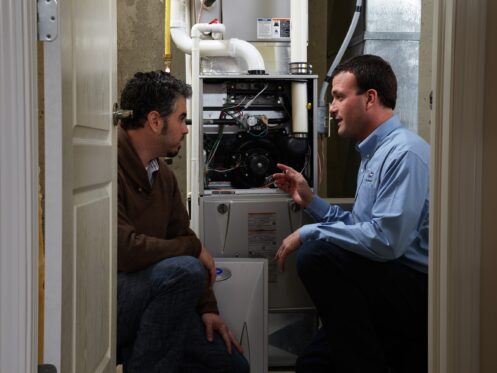When leaves begin to turn and you feel that first chill in the air, it’s time to give your furnace some attention before you crank up the heat. A quick inspection, filter swap, and safety check can help produce smoother operation, lower bills, and fewer surprises when cold weather settles in. At Landen Heating and Cooling, in Zebulon, NC, we take pride in helping homeowners head into fall with confidence rather than last-minute panic.
Inspect and Replace Your Air Filter
Your furnace’s filter plays a vital role in keeping air flowing and protecting internal components from dust buildup. When you walk to the return grille, press your hand against the filter door and slide it out, hold it up to the light. If the view is clouded with debris or lint, it’s past its prime. Swapping in a fresh filter restores proper airflow and reduces work on your blower motor.
Opt for a media filter rated for residential furnaces and match the thickness and size stamped on the old one. Slide it in with the arrow pointing toward the furnace cabinet, then close the door firmly. In models with washable filters, rinse under a steady stream of water until the foam or mesh appears clear. Then, let it dry completely and reinstall it. Clean filters help your system keep heat moving efficiently through ductwork, preventing cold spots and saving you from chilly mornings when you least expect them.
Lubricate Bearings and Motor Assemblies
As seasons shift, the bearings on older furnace blowers can stiffen from lack of use. Locate the blower housing near the bottom of the unit and look for oil ports on the motor casing. Consult your owner’s manual for the correct lubricant, typically a non-detergent SAE 20. A couple of drops on each port will loosen moving parts and keep your blower wheel spinning freely. Turn the blower by hand before and after oiling. It should turn smoothly with minimal resistance or wobble.
If it still feels rough or you hear grinding when the furnace kicks on, the motor may need professional attention or replacement. Well-lubricated bearings reduce friction losses. They also decrease the rattles and squeaks that can echo through walls and floors, allowing you to enjoy the quiet hum of a well-tuned heating system instead of worrying about hidden wear.
Test Safety Controls and Ignition System
Your furnace relies on a network of sensors and switches to light burners safely and shut down operations if something goes wrong. Start by turning off the power at the switch or breaker, then open the cabinet door to examine the flame sensor rod and ignition assembly. Clean the sensor gently with fine steel wool to remove any film that could prevent proper flame detection. Close the door, restore power, and raise the thermostat setpoint to listen for the ignition sequence.
Modern furnaces use spark ignitors or hot surface ignitors to light the gas. Observe the burner flames through the service window; each flame should burn steadily and blue. If you see yellow tips, soot, or flicker, ask a technician to inspect the gas pressure and adjust the air shutter so the mixture stays clean. Finally, trigger a safety shutdown by cutting power mid-cycle. When you restore power, the furnace should start again without hesitation. That proof of reliable restart means your safety controls respond as intended.
Clear and Test the Condensate Drain
High-efficiency furnaces create condensation as they extract heat from exhaust gases. That water runs down a trough into a drain tube, which can clog with dust, mold, or sludge. Locate the PVC drain line and gently remove the end cap or disconnect a flexible hose. Place a shallow pan underneath and pour a cup of vinegar into the tube to dissolve any build-up. After ten minutes, flush with clean water until it flows freely into the pan. Inspect the trap, an inverted U-shaped loop, so it holds water and prevents sewer gas from backing up. If the trap sits dry, pour in fresh water before resealing. After test flushing, reattach the line and restore power. Run a cooling or heating cycle and watch the connection; clear water should drip steadily. A free-flowing condensate drain prevents overflow switches from shutting your furnace off mid-season, sparing you the cold surprise of a locked-out system.
Calibrate Your Thermostat and Controls
The thermostat acts as your furnace’s on/off switch and communication hub. Open the faceplate and remove any dust from the contacts and wires. Level the unit against the wall so it senses room temperature accurately. Check that its temperature reading matches the handheld thermometer when held in the same spot. Then, adjust the offset setting if the difference exceeds two degrees. If you have a programmable model, review your schedule so it accommodates your daily routines. Lower comfort levels when the office is empty and bring warmth back just before you return.
Smart thermostats require firmware updates and Wi-Fi checks for geofencing and remote alerts. Confirm that control voltages measure within the recommended range at the furnace control board terminals. A tight thermostat-furnace link prevents short-cycling that wastes energy and causes uneven heating across rooms.
Verify Carbon Monoxide Detectors and Safety Alarms
Gas-fired furnaces always carry a small risk of combustion byproducts escaping into your home. Walk through the living areas and test each carbon monoxide detector per the manufacturer’s instructions. Replace batteries in alarm units so they chirp a clear warning tone if your detectors are more than six years old, and swap in new ones to ensure sensor reliability. Install a digital display model in the hallway near bedrooms to see real-time carbon monoxide concentration levels.
Check smoke alarms in the furnace room and adjacent hallways. Press the test button on each unit and listen for a brisk, solid beep. If any alarm responds sluggishly or makes low-volume noises, replace the device. Working smoke and CO alarms alert you to unseen hazards that can arise if a heat exchanger cracks or a vent pipe loosens during a freeze cycle.
Evaluate Safety Shutdown and Emergency Controls
Your furnace has manual and automatic safety cutoffs. Identify the power switch on the cabinet and label it clearly. Test the high-limit switch by letting the furnace run with the return grille covered. It should shut off once the internal temperature climbs above its setpoint. Reset it only after the cabinet cools completely.
Locate the emergency shutoff valve on the gas line and practice closing and reopening the lever. A small tag or bright tape marks its position. This quick familiarity matters if you ever smell gas or see flames under the burner. Lastly, check the secondary drain shutoff float in high-efficiency units. Lift it to simulate a clogged drain and watch the furnace power down. Those checks confirm that automated safety systems are ready to intervene if a component fails.
Keep Warm This Fall
Regular fall furnace care doesn’t just prevent breakdowns, but it guards against high energy bills and uneven warmth. We also specialize in duct cleaning and carbon monoxide testing to round out your seasonal comfort. Give your system the attention it deserves this autumn. We also offer preventative maintenance through our Comfort Club membership!
Schedule your furnace maintenance with Landen Heating and Cooling today and enjoy cozy evenings without the worry of sudden chills.


